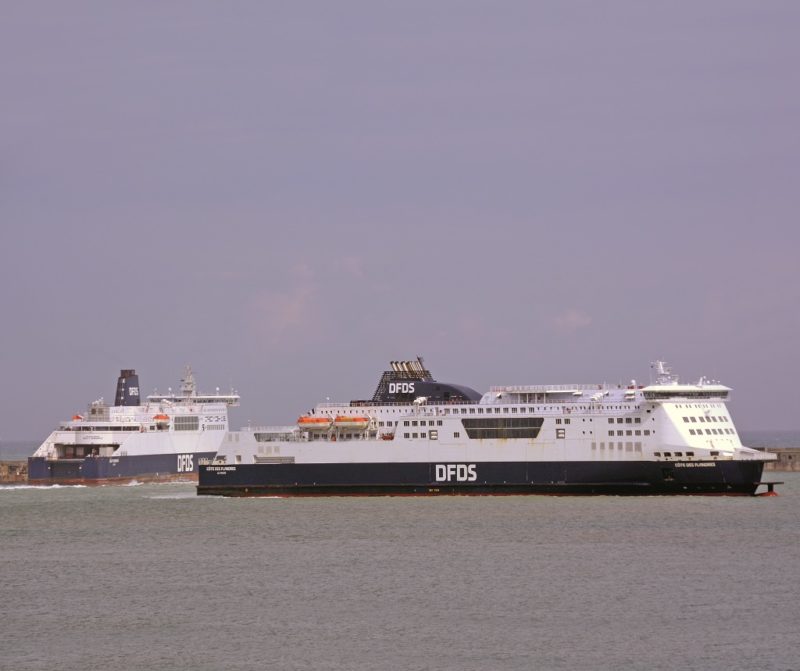
Dover is a very important ferry, cruise and reefer cargo port in Kent, with two big cruise terminals, a smaller cruise terminal, six ro-ro linkspan ferry berths, two cargo berths and two entrances to the port, which are around one kilometre (0.61 mile) apart. The Western entrance is 225 metres wide, and the Eastern entrance is 200 metres wide. Due to fast moving and turbulent tidal streams, the best time to enter the port is two hours before High Water, and one hour after. The direction of the tide across the eastern entrance is constant from north to south, with the set of the tide reversed during High Water. Mean tidal ranges are 5.9 metres at springs, and 3.3 metres at neaps.
The Port of Dover is the busiest ferry port in Europe handling £119 billion of trade or 17% of the U.K. trade in goods, and with an annual turnover of £58.5 million in 2019. An estimated 20 million passengers and 1.6 million vehicles pass through the nearby Channel Tunnel at Folkestone, opened in 1994, while Port of Dover traffic is 13 million passengers and five million vehicles. The modern port features a large artificial harbour constructed behind impressive stone piers and a defensive concrete breakwater. The port is divided into two main sections , the Eastern Docks with the big ferry terminal, and the Western Docks with two cruise terminals, cargo facilities and a yacht marina.

HISTORY OF THE PORT OF DOVER
The origins of the port can be traced back to Roman times when the port was known as Dubris, with Julius Caesar commenting that his fleet was moored in the ‘Haven with a cleft between two imposing chalk hills’. This was the sheltered Dour river estuary, only 21 miles from France, giving him a strategic position for advancing along straight Roman roads e.g. Watling Street throughout England, Wales and Scotland. The very straight Roman road of Watling Street stretched from the Dour valley at Dover to London via Lydden, Canterbury, Rochester, Dartford and Crayford.
The development of the port led directly to the growth of Dover as a settlement and over many centuries to the fortress of Dover Castle and the extensive fortifications of Dover Western Heights. Evidence of the Roman occupation of the port exists today in the foundations of the Pharos (Lighthouse) of AD 43 on the cliffs on the east side of the valley, whose four lower stages survive and the hollow shell can be entered.
Dover was one of the harbours of the Saxon shore, and in the 9th century, Alfred the Great created a network of fortified settlements across his kingdom called ‘burghs’. Dover was made a ‘burgh’ town, in which in the event of any attack all of the men of the area could gather together in the local ‘burgh’ to fight. An earth rampart probably protected it with a wooden palisade on top. Dover eventually became a heavily guarded fortress town with a castle and many miles of tunnels to quickly move troops around the extensive site.
Dover grew further after the Norman invasion of 1066 at Pevensey to the west of Dover, with the Battle of Hastings at the village of Battle, four miles north of Dover, settling the military issue once and for all time. A castle stood at Dover in 1068 after William the Conqueror built over the earthworks of an Iron Age fort.
The present castle was begun in the reign of Henry II and was ready for use in 1168. The most remarkable feature is a large keep protected by several curtain walls, and it was one of the last rectangular keeps to be built before castle design moved on to polygonal or circular towers. The keep is very similar to that of Newcastle upon Tyne Keep by the same master builder, but Newcastle predates Dover by a decade.
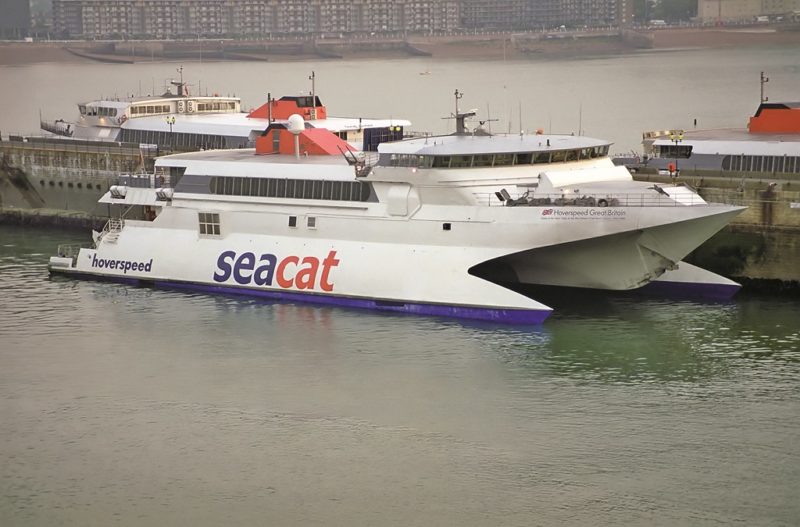
Louis, Dauphin of France, laid a long unsuccessful siege in 1216, however the subsequent medieval history was relatively peaceful. Heavy fortifications were added during the Napoleonic Wars. Dover became one of the five Cinque Ports with many privileges that came with it, the Lord Warden of the Cinque Ports is also the Constable of Dover Castle. After the martyrdom of Archbishop Thomas Becket at Canterbury Cathedral in 1170, Dover became the main port of entry for foreign pilgrims. The Third Crusade led by Richard Lionheart and subsequent Christian Crusades to Jerusalem and the Holy Land, as well as the stunning victory of Edward III at the Battle of Sluys in 1340, led to a very strong defensive wall built around the town and the castle. Henry V was brought back through the port after his death in France in 1422, and Henry VIII sailed from the port in 1520 to meet Francois I of France for the royal summit known as the ‘Field of the Cloth of Gold’. Henry VIII became interested in improving the harbour and ordered the promontory to be extended in the form of a pier. This work was never fully completed, as the still water in the lee of the pier caused a deposit of shingle across the front of the bay.
The ‘Great Pent’ was an enclosed pool or ‘pent’ of water formed by a wall built in the 1580s across the Dour river, and by means of sluices, the harbour could be periodically scoured of shingle.
The work was undertaken by labourers from the Romney Marshes during the reign of Elizabeth I, and the later construction of Wellington Dock, designed by James Walker in the 1830s, gives the location of the useful ‘Great Pent’.
James I of England, and also James VI of Scotland, gave Dover Harbour Board its royal charter in 1606 for the running of the port.
Since then, the constitution of the Board has been changed on a number of occasions by Acts of Parliament. It currently exists with a status of eight people, a Chairman, and four other members appointed by the Secretary of State, two ex-officio members, and an eighth member appointed by the other seven members.
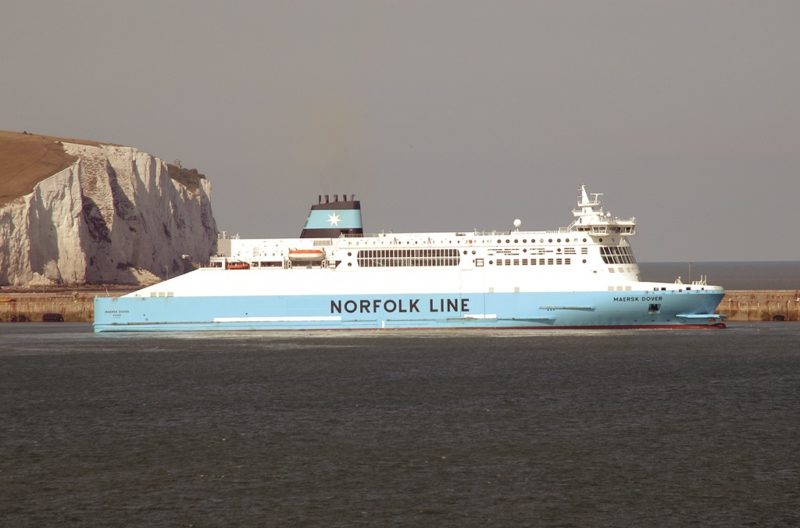
After the threats of invasion of the Napoleonic Wars in the first decade of the 1800s, the Admiralty selected Dover as the most suitable location of a harbour of refuge for the fleet between the strong ports of Portsmouth Dockyard and Chatham Dockyard. In 1847, construction of the Admiralty Pier began on what became known as the Western Arm, whose completion in 1871 stopped the shingle and silt of the harbour mouth, as it cut off the drift of this material from the direction of Folkestone. The Admiralty Pier was constructed using a foundation of Portland stone blocks surmounted by granite and durable Bramley Fall stone on the seaward facing exterior. The Eastern Arm construction from 1897 onwards established the current harbour together with the Southern Breakwater, to create two entrances to the port.
The harbour was generally acknowledged by experts as one of the greatest harbour construction projects of that time, forming a harbour of 700 acres (24 hectares) with a total area including land of 1,050 acres, and a depth from 5.6 up to 9.0 metres. Blocks of concrete weighing 30 to 40 tonnes were used, with granite facings to those that were to be placed on the outside of the walls above the water level.
Fortifications for defending the harbour had been proposed from 1850, but the design of the later Fort Gun Tower section of the Admiralty Pier had been changed and amended in size and function. The defence consisted of a pair of 80 tonne sixteen-inch muzzle loading guns housed within a 900 tonne steam powered revolving iron turret of an Armstrong design. More modern six-inch breech loading guns were provided in concrete gun emplacements to the top of the fort between 1907 and 1909. These guns were removed after World War II, but the footprint of the gun emplacements remain. The port was heavily shelled and damaged by long range guns of the Cape Gris Nez batteries before they were overrun by advancing Allied troops in September 1944. The armed and fortified wider environs of the Fort, the Admiralty Pier, and the approach roads were gradually dismantled up to 1958. Two lights shine today on the Southern Breakwater, and one on Admiralty Pier to guide ships into port.
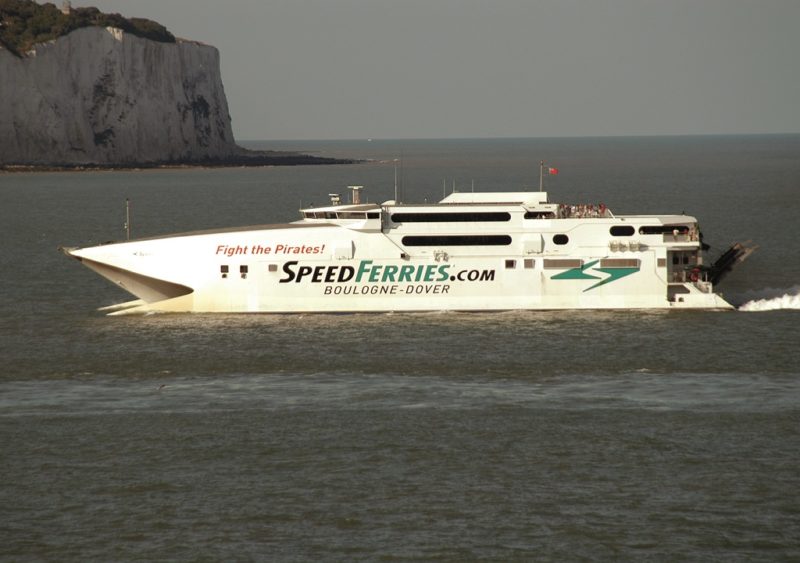
STANLEE SHIPBREAKING & SALVAGE Co. Ltd.
The Eastern Docks consisted of ‘The Camber’, a partly enclosed dock formed by a small pier at right angles to the Eastern Arm. This was used for shipbreaking during World War I, when the Admiralty began dismantling ships there. The Stanlee Shipbreaking and Salvage Co. Ltd. took over this shipbreaking operation commercially in 1920. Many of the ships broken up were unwanted battleships, battlecruisers, cruisers, destroyers, submarines and small warships from World War I, but machinery and scrap metal were also handled e.g. the dismantling of the Dover Promenade Pier. The yard was busy as a naval repair yard during World War II, but was eventually closed in 1964 to make way for port redevelopment and a car ferry terminal.
Fifteen destroyers and submarines were purchased for scrapping during 1919/20 including the destroyers Kennett and Brazen, naval tender Firebrand, and submarine H51. These were followed by the battleships Duncan, Canopus, Vengeance, Victorious, Superb, Temeraire and the battle cruiser Indomitable, as well as the cruisers Medusa, Pomone and Flora, sloops, minelayers and minesweepers.
The scrap was loaded into cargo ships for the blast furnaces of the North East England and South Wales. The minesweeper Ford was purchased in October 1928 and was sold on in 1930 to their neighbours Townsend Brothers in the Camber. Ironically, Stanlee let Townsend use its cranes to load cars at the Camber into their pioneering car ferry Forde, little realising that the future success of car ferries would eventually force the yard out of business in 1964.
General cargo ships were broken up during the ten year period from 1948 to 1958, including Empire Flaminian, Empire Longford, Woermann cargo liner Tanganyika, Hythe, Gronland, Channel steamer Biarritz, tanker War Sepoy, famous Solent paddle steamer Lorna Doone, and the naval paddle tugs Grappler and Ancient. The yard also helped clear up the D-Day landing sites, salvaged parts of the Pluto underwater fuel pipeline, the two Mulberry harbours and blockships, as well as many coastal defence guns around the White Cliffs and the wider Kent coast. The yard closed down on 31st December 1964.
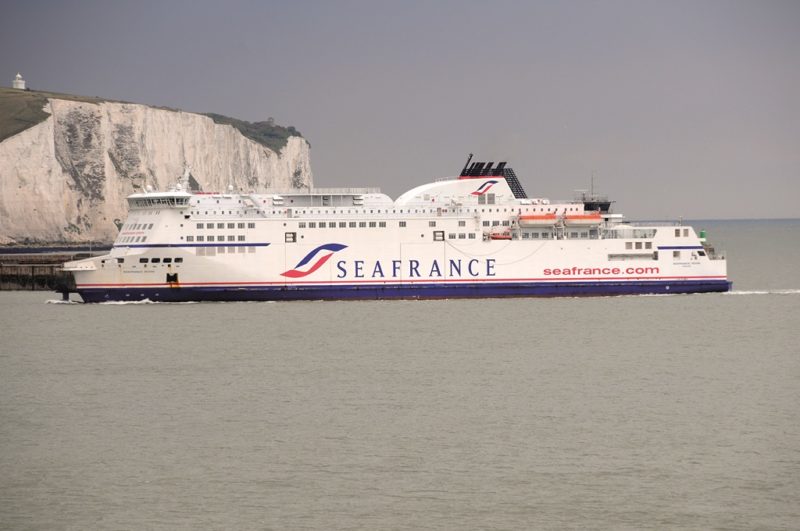
COAL EXPORTS FROM DOVER
In 1930, Dover Harbour Board had a small fleet of twin screw harbour tugs, including Lady Brassey of 362 grt and Lady Duncannon of 185 grt, both built by J.P. Rennoldson of South Shields in 1913/14, as well as the single screw salvage tug Dapper of 419 grt built in 1915 at Camden in New York. A dredger and a dumb barge completed the fleet, with the tugs used in the berthing of colliers from 1930 when an aerial ropeway or cable car system carried coal from Tilmanstone Colliery, 7.5 miles to the north, emerging through twin portals half way up Langdon Cliffs directly above the Eastern Arm. The ropeway or cable car system had a central powerhouse at Dover, and then swung outwards and descended across to the Eastern Arm, and used 600 one ton buckets that departed at intervals of 21 seconds and travelled at 4.5 miles per hour to reach the coal staith. This ingenious system transported coal all of the way from the Kent colliery for shipment at the rate of 120 tons per hour. The twin portals have now been bricked up but can still be seen from the ferry port.
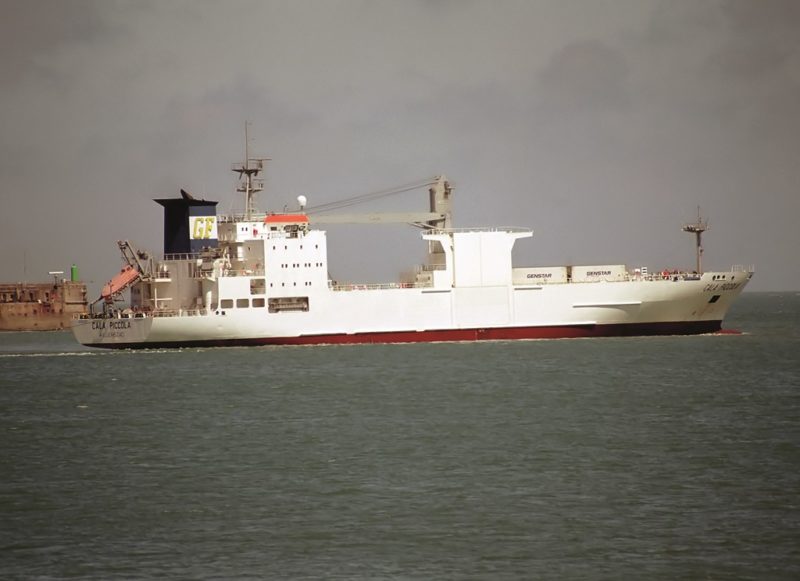
DOVER MARINE RAILWAY STATION
At the Western Docks, rail services arrived in the port from 1844, being the terminal for the famous ‘Golden Arrow’ train to France as well as other Cross-Channel train services. Dover had its own magnificent Dover Marine Railway Station, designed by Percy Tempest for the station frontage in 1912. This is listed as a Grade II listed structure by English Heritage, with the elevation drawing towards the Lord Warden Hotel showing a central magnificent entrance with two smaller entrances to the side and an extension to one side with a chute. Initial plans for the South Eastern and Chatham Railway Company were prepared in 1906. Four railway tracks were arranged around two island platforms, and with a pedestrian bridge connecting the building to the road network close to the Lord Warden Hotel, and to a Stair Tower for access. The covered walkway and Stair Tower were divided internally to separate station use from that of access to the Admiralty Pier Walkway. The Marine Station Building was constructed between 1912 and 1914 on land reclaimed between 1907 and 1913 from the harbour, and inside the line of the Admiralty Pier. The building can be summarised as:-
- A handsome ‘Beaux Arts’ style railway station that has been virtually unaltered and renovated for use in 1996 as a ‘state of the art’ cruise terminal, retaining the old station architecture for all to enjoy.
- It contains the War Memorial of the South Eastern and Chatham Railway Company including a fine bronze sculpture.
- It had a military role as a point of departure of an estimated five million troops for the Western Front during World War I, with 1.5 million troops returning wounded, and for the Dunkirk evacuation of World War II. In 1920, the remains of the ‘Unknown Warrior’ were landed prior to transport to London and a ceremonial internment at Westminster Abbey. Dover Marine Railway Station closed in 1994.
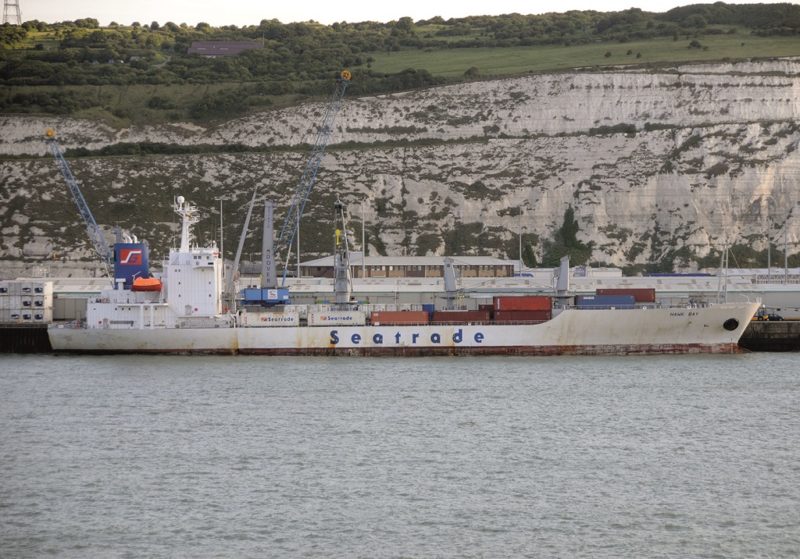
THE PORT DURING AND AFTER WORLD WAR II
Dover was constantly bombarded by over 1,800 shells from the Cape Gris Nez batteries during the six month period from June to December 1940 after France was overrun. The miles of medieval tunnels and the Underground Hospital built at that time treated the living military and civilian casualties with bandages and first aid care, however 221 Dover fatalities occurred during the war from shelling. During the Dunkirk evacuation (Operation Dynamo) of the British Expeditionary Force (BEF) over 330,000 British and Allied troops were brought back to English ports, principally Dover.
Admiral Ramsay was recalled from retirement to mastermind the evacuation, after German Panzer forces split the British and French forces on 20th May 1940 when they reached the French coast. Lord Gort, Commander of the BEF, ordered the full retreat on 25th May, with French troops covering the retreat. Thirty British destroyers, and many minesweepers and trawlers, as well as Channel excursion steamers, and up to 800 ‘Dunkirk Little Boats’ and cabin cruisers as small as twenty feet in length, played a brave and successful part in the rescue of the BEF, who were badly needed back in England to fight again. The drama of the evacuation raised British morale significantly, in what after all was a military defeat. The Royal Navy lost several destroyers in the Cross-Channel trips packed with troops, and the French Navy lost the destroyers Bourrasque, Epervier, Foudroyant and Siroco, with Bourrasque built in 1926 mined and sunk off Nieuport with only 559 survivors from 1,200 troops and crew.
Watchful was typical of the ‘Dunkirk Little Ships’, built in 1935 as Brit of 75 grt on dimensions of overall length of 88 feet, moulded beam of 19.5 feet and moulded depth of 5.0 feet by Fellows of Great Yarmouth as an excursion ship at that port. She carried 200 passengers, and was requisitioned on 16th September 1939 and renamed Watchful as a tender for British destroyers in Yarmouth Roads. She was deployed to Dunkirk on 29th May 1940 and rescued over 900 troops, and continued in naval service until the end of the war. She resumed excursions in 1946 at Great Yarmouth, but moved to Scarborough in the Spring of 1951 as Yorkshire Lady, becoming Coronia in 1968 on a change of owner. In 1985, she sailed for Gibraltar for excursions around ‘The Rock’, but returned in 1991 for more excursions from Scarborough and Bridlington. She has been restored as a restaurant in Hartlepool Marina today, regaining her wartime name of Watchful and her light grey hull.
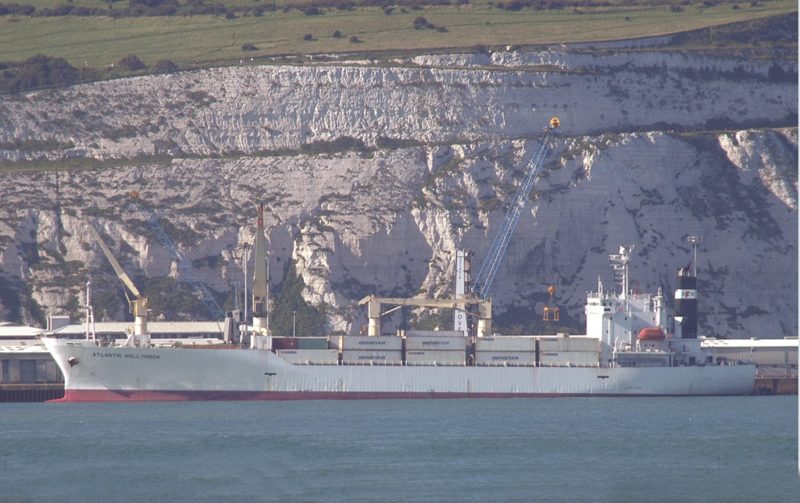
The first two ro-ro ferry berths in the Eastern Docks were opened on 30th June 1953, with 100,000 vehicles transported during that summer season. The British Railferry Dinard of 2,291grt and built in 1924 by Wm. Denny & Bros., was modified for the purpose to carry 75 cars and 400 passengers. A quartet of famous British Rail pioneer car ferries were built as Lord Warden in 1952 by Wm. Denny & Bros., Maid of Kent in 1959 by Wm. Denny & Bros., Dover in 1965 by Swan, Hunter & Wigham Richardson, and Holyhead Ferry 1 in 1965 by Hawthorn, all having a car deck to accommodate 120 to 200 cars, together with 1,000 passengers.
The ferry docks at both Calais and Dover have since been built with extendable ramps attached to the roadways, and ferries berth stern first with specially designed sterns. It soon became clear due to the popularity of foreign holidays taken with the car, that all available space in the Eastern Docks would be used up for this purpose. In the mid-1960s, land was reclaimed at the Eastern Docks seawards of the original Customs Hall building, and a passenger terminal and a new berth was constructed. This berth No. 4 was a new generation double deck, single width type, which allowed two lanes of vehicles to be loaded or discharged simultaneously, and was opened in 1965.
By the late 1960s, it had become painfully obvious that further big increases in car transport were to be seen together with transport of lorries and ro -ro freight. Dover Harbour Board had to provide further ferry linkspan berths. Work on Berth No. 3 began immediately as another double deck, single width type. In 1965, only several hundred lorries and trailers were transported, rising to 730,000 in 1985 and to over one million in 1990 for the first time. In 2006, 2.3 million lorries and trailers were transported, and today the figure has risen to almost three million commercial vehicles.
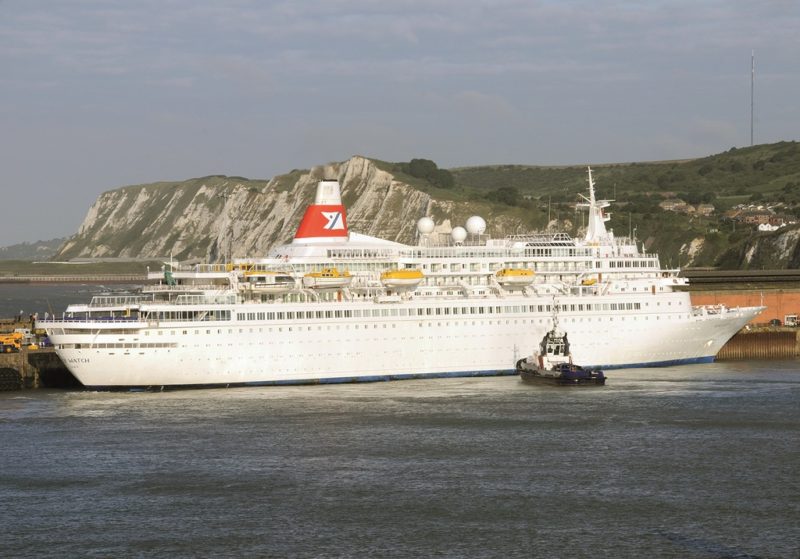
The Western Docks area of 15 acres of reclaimed land was developed at a cost of £12 million into a Hovercraft terminal in use from 1968 until the early 2000s decade for a Cross Channel Hovercraft service run by Hoverspeed and three enormous St. Margaret class hovercraft. Hoverspeed also ran catamaran services until being declared bankrupt in 2005. Another catamaran service ran from 2004 until November 2008 run by a single ship of Speed Ferries called Speed One. She ran five times daily services to Boulogne, however the hoverport has now been demolished and redeveloped as the Seatrade Reefer Terminal cargo handling facility.
The facilities of the Port of Dover in 1970 handled the import of coal, fruit, general cargo, oils, stone, timber and wood pulp, with exports of general cargo and machinery. They comprised an Outer Harbour and an Inner Harbour, separated from the outer by the Prince of Waler Pier. The Western Docks included the Admiralty Pier, Train Ferry Dock, Tidal Basin and the Granville and Wellington Docks. These in detail were as follows:-
Admiralty Pier of length 1,260 metres with the Dover Marine Railway Station and four deep water berths with alongside depths of between 5.2 and 7.9 metres. The three inner berths were used for Cross Channel ferries, two for passengers and one for ro-ro ferries.

Prince of Wales Pier with a north east side of length 488 metres with alongside depths of between 7.5 to 8.6 metres, berthing only by special permission, and on the south west side a hoverport with modern facilities.
Train Ferry Dock operated by British Rail.
Tidal Basin gave entry to the wet docks and partly dried at low water. The entrance was 140 feet wide with alongside depths of between 4.5 and 5.9 metres, and quay lengths of 335.0 metres.
Granville Dock with an entrance of 65 feet in width and a depth over the sill of between 5.2 and 6.4 metres. A total quay length of 580.0 metres, with transit sheds of good capacity served by electric cranes of 3 tonnes capacity and mobile cranes of 7 tonnes capacity.
Wellington Dock with an entrance width of 70 feet, depths over the sill of between 3.3 and 4.5 metres. Transit sheds of good capacity as well as an open storage yard served by mobile cranes of 7 tonnes capacity. The north end of the dock had a patent slipway for repairs to fishing and small craft up to 50 metres in length.
The Eastern Docks included the Eastern Arm, the Camber, as well as ro-ro ferry berths, as follows:-
Eastern Arm of total length of 518 metres of quays accommodating ships up to 8.2 metres in draft, with bunker and oil pipe connections.
The Camber had jetties on three sides and alongside depths of between 3.5 and 6.0 metres.
East Ro-Ro Berths near the Eastern Arm were separated by dolphins for vessels up to 122.0 metres in length and drafts of up to 5.8 metres, as well as oil berths and three gantry cranes of 20 tonnes in capacity, two used in tandem offered container lifts of 40 tonnes capacity. Mobile cranes of up to 10.0 tonnes capacity.
Car Ferry Terminal had two new ro-ro linkspans (Numbers 3 and 4) between Piers A and B with alongside depths of between 5.6 and 6.3 metres. More new ro-ro berths were planned.
Hoverport situated to west of Pier B.
Two tugs of 1,200 horse power provided named Diligent and Dominant of 161 grt and built in 1957/58, with a twin screw grab hopper dredger of 350 grt on order and to be named Admiral Day when completed in 1971.
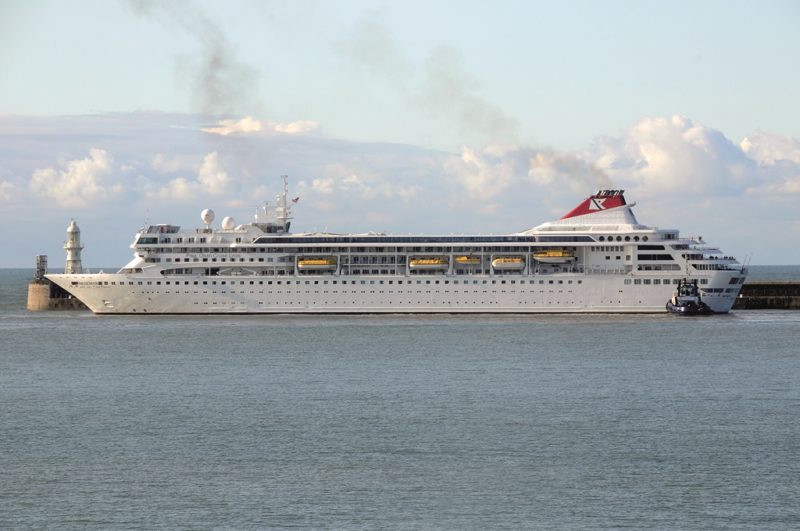
Documents required to be shown by vessels arriving included passenger list, crew list, tobacco, spirits and stores lists. Certificates of deratting, health, load line, safety equipment, gross and net tonnages, cargo documents and port of registration of the vessel. Pilots boarded vessels one mile south east of the Eastern Arm, and approaching vessels contacted Dover Port Control when three miles off the port. Visual Traffic Signals were exhibited at both port entrances, consisting of green lights by night and red balls by day.
During the 1970s, the new method of crossing the English Channel by hovercraft gained customers and momentum, with all three big St. Margaret class fully employed at the 1978 built terminal in the Western Docks. In the inner harbour of the Western Docks, traditional cargo methods declined and a new marina was built in the Granville and Wellington Docks, together with the new De Bradelei retail development. Any lingering doubts about the future of the port by the opening of the Channel Tunnel at Folkestone in 1994 were dispelled by two further double deck, single width linkspan ferry berths opened in 2005 by H.M. Queen Elizabeth II. The port was able to celebrate its 400th Anniversary in 2006, the Royal Charter being granted in 1606, with further good growth and much increased freight traffic during that year.
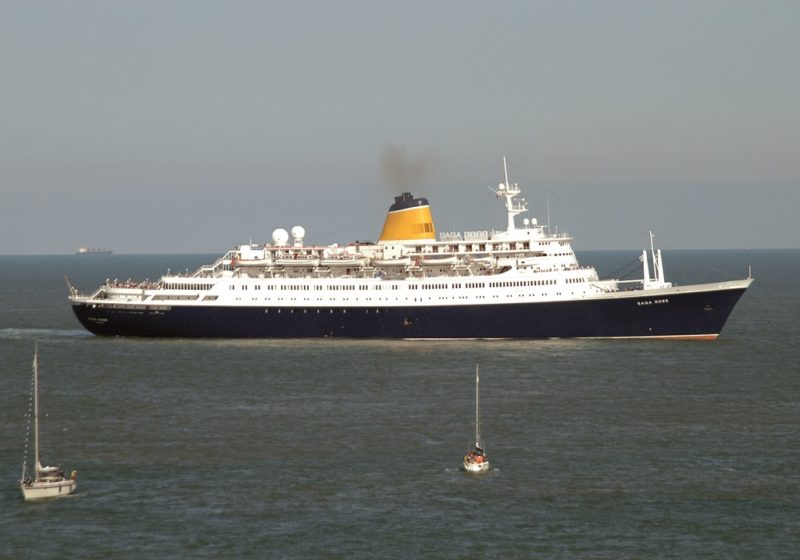
THE PORT OF DOVER TODAY
An £85 million capital development plan to build the new Seatrade Reefer Terminal on the former hoverport of the Western Docks over a construction period of five years, together with other new facilities, has increased the amount of new cargo coming through the port at these two new berths. A total capital expenditure of £250 million will have been made on Western Docks facilities by the time the project is completed in 2025. The facilities of the port today are as follows:-
CRUISE FACILITIES
Cruise Terminal 1 originally built in 1914 as Dover Marine Railway Station, rebuilt from 1996 as a ‘state of the art’ cruise terminal with every requirement for passengers, and retaining its original architecture.
- Cruise Terminal 2 completed in 2000 to the seaward of Cruise Terminal 1 on Admiralty Pier with good views from its lounges across the harbour to the famous outline of Dover Castle.
- Cruise Terminal 3 built at the seaward end of Admiralty Pier for very small cruise ships of up to 150 metres overall length.
- The two main cruise terminals offer the following facilities:-
- Fast efficient check-in
- Spacious and comfortable lounges
- Well stocked cafes and bars
- Washrooms, some with full facilities for disabled people
- Lifts to all floors
- Easy access car park with electric shuttle buses provided to the terminals
- Bureau de Change for all currencies around the world
- Wheelchair friendly ramps and walkways
- Baggage handling at carousels
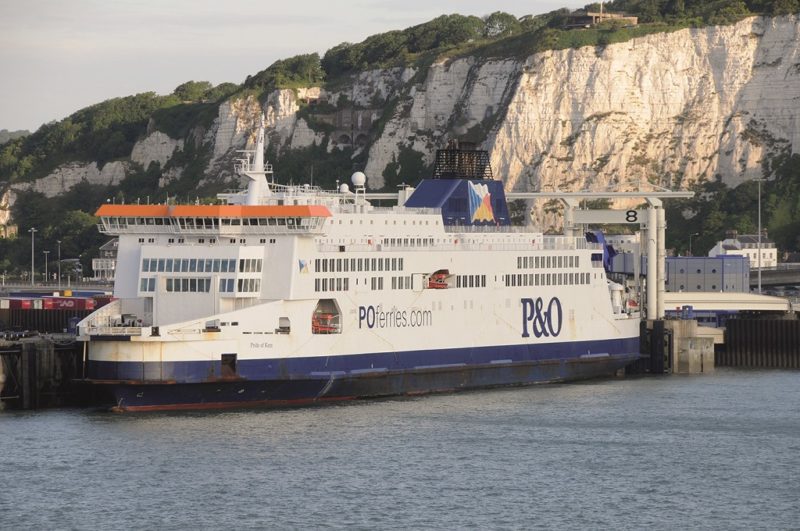
FERRY FACILITIES
In peak summer season, there are up to forty sailings per day to Calais and Dunkirk by three ferry lines of P. & O., DFDS Ferries, and Irish Ferries. Ferries take 1.5 hours to reach and unload at Calais linkspans, and two hours to reach and unload at Dunkirk linkspans. Six linkspan ferry berths can be brought into service to cope with the huge demand. These ferry facilities include:-
- Eastern Ferry Terminal with electric shuttle bus connections
- Passenger Service Buildings (West) on the west side of the port
- Cash points, vending machines, free wi-fi, and many shops
- Special needs facilities for severely disabled, blind and hard of hearing people
- Lounges and rest room
- P & O. Ferries in recent years have operated the big passenger ferries Spirit of France, Spirit of Britain, Pride of Kent, Pride of Burgundy and Pride of Canterbury to Calais, as well as freight only ferry services. P. & O. took a controlling interest in the British ferry industry with a £350 million purchase of the European Ferries Group in November 1987. This was itself a merger of Townsend Car Ferries Ltd. of Dover with ferries Free Enterprise I, II, III, IV, V, VI, VII and VIII with Southampton based Thoresen Car Ferries Ltd. with ferries Viking I, II, III, IV and Viking Valiant, Viking Venturer, Viking Viscount and Viking Voyager.
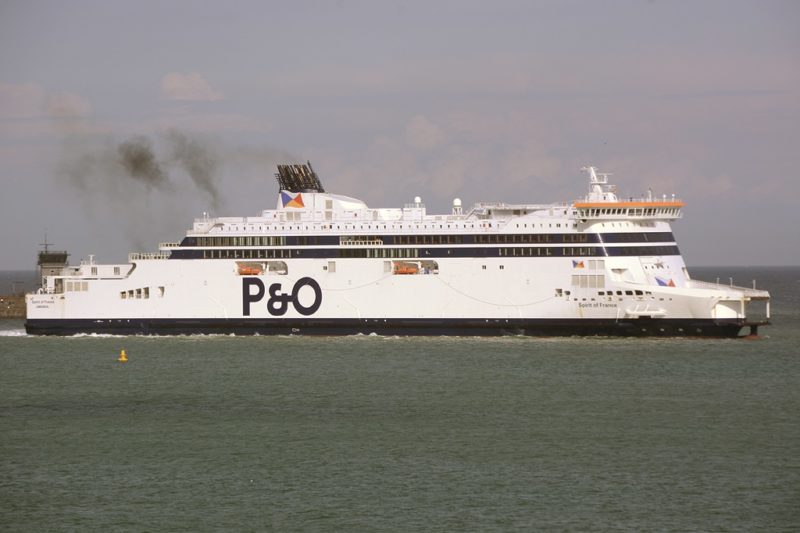
DFDS Ferries in recent years have operated the big passenger ferries Dunkerque Seaways, Dover Seaways and Delft Seaways from Dover to Dunkirk, and Cote d’Opale, Cote des Flandres and Cote des Dunes on the service from Dover to Calais. Cote d’Opale is a new economical Stena ‘E-Flexer’ design completed in 2021 and on charter from Stena, Cote des Flandres was built in 2005 with accommodation for 1,500 passengers, and 400 cars on her car deck, and Cote des Dunes was built in 2001 as Seafrance Rodin with accommodation for 1,500 passengers, 700 cars or 150 lorries on her car deck, and with a service speed of 25 knots. DFDS acquired Norfolk Line from the Maersk Group in 2010 together with its Dover to Dunkirk route, and then in February 2012 launched a new Dover to Calais route.
Irish Ferries was formed in 1973 for Irish Sea operations, and since June 2021 have operated the big passenger ferries Isle of Inishmore, Isle of Innisfree and Isle of Inisheer on their service from Dover to Calais.
Sail Link began a new passenger service for foot passengers and bike riders in September 2022 from Dover to Boulogne using commercial, powered sailing catamarans. The last Dover to Boulogne passenger service ceased in 2008.
SEATRADE PERISHABLE CARGO TERMINAL
Seatrade of Holland opened its fast, direct Zodiac fresh produce service at Port of Dover in July 2022, with cargo from the Caribbean countries of Colombia, Costa Rica, Guatemala and Honduras.
The reefer Swedish Stream, built in 1992 as Chiquita Scandinavia and later renamed Swedish Reefer, arrived in the port on 22nd July 2022, to join the Seatrade Rayo service launched to Dover in 2012 connecting the ports of Puerto Bolivar (Ecuador), Guyaquil (Ecuador) and Paita (Peru) with Dover and ports in France. Seatrade thus has had a long relationship with handling fresh produce into the Port of Dover Cargo Ltd. facilities. The latest sextet of Seatrade reefer vessels carry 2,260 TEU of reefer containers at 19 knots and were built in China in 2017/18 as Seatrade Orange, Seatrade Red, Seatrade White, Seatrade Blue, Seatrade Gold and Seatrade Green.
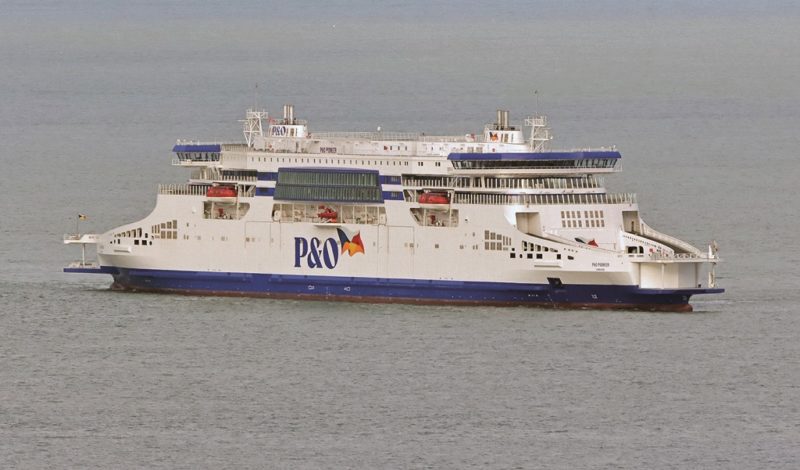
DOVER WESTERN DOCKS REVIVAL (DWDR)
This is a completely revamped and reconstructed former disused site of Dover Hoverport, with Seatrade reefer ships unloading reefer cargo opposite the three cruise terminals.
A large new marina has been built on a long curved area on the harbour side of the new Seatrade reefer terminal, and has attracted shops, bars, cafes and restaurants. The relocation and further development of the port cargo business and distribution centre from the Eastern Docks has been very impressive. The DWDR Project Office and DWDR Marketing Suite are very helpful in attracting new business to the port on this former disused Hoverport site. The DWDR facilities at Port of Dover Cargo Ltd. are:-
- Two deep water berths of length 250 metres and 300 metres, and alongside depth of 12.0 metres in the Western Docks
- Berth 4 measures 300 by 160 metres, but narrowing to 60 metres, with hinterland of 24,500 m2, with mooring dolphins extending the length of vessels to 350 metres.
- Berth 5 measures 250 metres by 40 metres with 41,500 m2 of hinterland
- Total terminal area of 9,630 m2
- Cold Chambers number eight with cargo cooled to +1 degree or to +14 degrees C.
- Cold Chambers each have 4,158 pallets of stored fresh produce
- Twin KONE cranes with a maximum lift of 125 tonnes, outreach up to 51 metres
- One TEREX Gottwald mobile crane of 90 tonnes maximum lift
- Three stack reefer container storage areas of 564 TEU (Berth 4) and 210 TEU (Berth 5)
- Equipment including twenty dock levellers, with two for use by Border Force personnel. A dock leveller is a piece of loading equipment designed to bridge the gap between a loading bay and a trailer, thus compensating and overcoming differences in vehicle loading heights.
- Heavy offshore, steel, aggregates, grain, break-bulk, general cargo, and project cargo are also accepted. The first imported steel cargo was received in 2021 of 10,250 tonnes of steel rebar in Jette Marit, rebar is reinforced steel bar to strengthen concrete. Steel coils, mesh, beams and plate also arrived in a large cargo of 63,400 tonnes of steel in the bulker Interlink Quality. Kent grain cargoes of 4,000 tonnes have been exported from Dover to Dublin, and similar sized aggregate cargoes have been imported.
- The Thanet Wind Turbine Farm off the Kent coast is maintained from Dover, and more wind farms are planned for the offshore Kent coastline.
CRUISE LINES ARRIVED IN 2022
- Hurtigruten Cruises 6
- Aida Cruises 20
- Saga Cruises 15
- Fred. Olsen Cruises 13
- Viking Ocean Cruises 11
- Carnival Cruises 9
- Royal Caribbean International (RCI) 5
- Disney Cruise Line 5
- TUI Cruises 3
- Phoenix Seereisen 3
- Seabourn Cruises 3
- Costa Cruises 2
- Celebrity Cruises 2
- Nicko Cruises 2
- Princess Cruises 1
- Sea Cloud Cruises 1
- Le Ponant Cruises 1
- Holland America Line 1
- Hebridean Island Cruises 1
- National Geographic Cruises 1
- Noble Caledonia 1
- Plantours & Partners 1
- GRAND TOTAL 130
The famous Hurtigruten coastal express passenger service in Norway takes eleven days to voyage between Bergen and remote ports in Northern Norway and back to Bergen, and is the best way to travel along this beautiful coastline in a country where travel is hampered by mountains and deep snow. Hurtigruten Cruises have operated adventure and expedition cruises to the Arctic, Antarctic and other areas of the world for two decades. The hybrid battery-powered expedition cruise ship Fridtjof Nansen called at Dover on 6th March 2020 and her sister Roald Amundsen for their inaugural cruises from Dover in 2021. The cruise ship Maud, named after Queen Maud of Norway operated from Dover in 2022 for Hurtigruten Cruises, and the Trollfjord, built in 2002 with accommodation for 822 passengers, will operate for Hurtigruten Cruises from Dover in 2023.

DOVER VTS SYSTEM
The Dover VTS (Vessel Traffic System) is located at the Eastern Entrance to the port, and has ten VTS Officers delivering a sophisticated traffic organisation and information system covering all movements of ferry, cruise ship and cargo ships every day in and out of the port. Dover Port Control is in constant contact with the Harbour Patrol Launch, which will be directed to intercept any ship not complying with Port Control’s instructions or to assist as required. Dover Port Control has a comprehensive, integrated AIS (Automatic Identification System) radar system providing coverage, both inside and outside of the port, so it can prevent casualties in poor weather conditions. A £2 million upgrade to the system software was made in 2018 to maintain it as one of the best AIS port systems in the world.
The benefits of the system are:-
- Safety of Life at Sea (SOLAS)
- Safety of Navigation to Avoid Human Error, the main cause of marine accidents
- Efficiency of vessel traffic movement
- Protection of the marine environment
- Protection of the adjacent communities and infrastructure
- Contribution to the efficiency of related activities and supporting maritime security
- Provision of a clear, comprehensive traffic image of ships in the port environs at all times and in all poor sea and all weather
- All ships are fitted with Automatic Information System (AIS) transponders, whose positions are plotted on VTS screens with markers showing their direction of travel and intended changes of course to enter port.
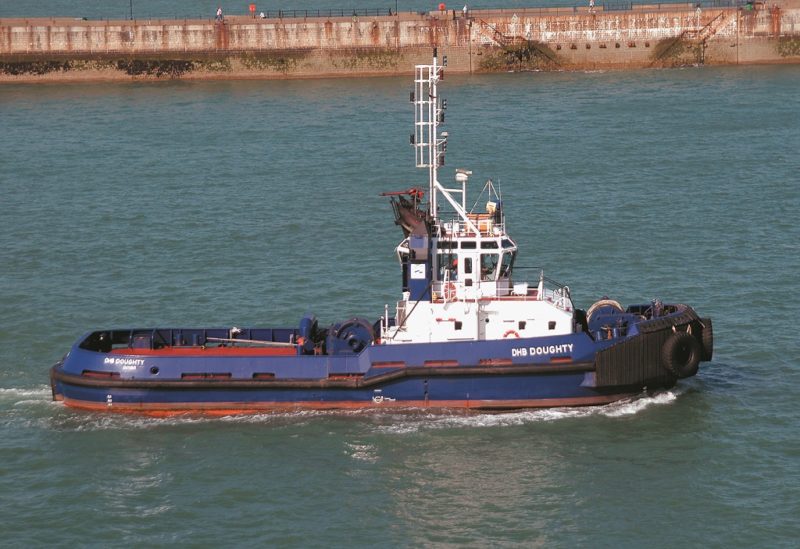
TRAFFIC SEPARATION SCHEME (TSS)
Dover ferries are travelling at high speeds of 26 knots with up to 2,400 passengers onboard at right angles to the two segregated shipping lanes in the English Channel, with outward traffic in the South West Lane steering close to the English coast, and inward traffic in the North East Lane steering close to the French coast. This can be hazardous, and is monitored by the Dover Coastguard, which has sophisticated monitoring of the Traffic Separation Scheme (TSS) in the Channel from the Langdon Battery on the White Cliffs, as well as of all vessels passing Dover, which are instructed to keep at least one mile from the Southern Breakwater of the port. The French Coastguard at Cape Gris Nez monitors the Traffic Separation Scheme (TSS) from the French coast. Langdon Battery is a short walk along the White Cliffs from Dover before Fan Bay and South Foreland are reached.
The Channel Navigation Information Service (CNIS) helps vessels navigate safely and prevents collisions in the Dover Strait. Over 400 commercial ships use the Dover Strait every day, which is under full radar surveillance and operates the Traffic Separation Scheme (TSS). The Dover Strait is a mandatory reporting area, with all vessels over 300 gt required to mandatorily report their position before entering the South West Lane or the North East Lane. There are many other congested shipping areas in the world that are under full AIS radar surveillance to avoid collisions and casualties e.g. the Straits of Malacca between Sumatra and Malaysia, the Oresund and Storebaelt in Denmark, New York Harbour, Liverpool Bay, the Isle of Man East and West coasts, and the Great Lakes between Canada and the U.S.A.
PORT OF DOVER HARBOUR CRAFT
The grab hopper dredger David Church of 671 grt was completed by Appledore Shipbuilders Ltd. at Appledore in North Devon in 1995 for operations in the enclosed docks and outer harbour. She is fully owned by Dover Harbour Board. Two new owned tugs made their first appearances in Dover in Millennium year named DHB Dauntless and DHB Doughty. Their hulls were built in Russia at Severodvinsk and they were completed at Gorinchem in Holland by Damen Shipyards. They have dimensions of overall length of 30.82 metres, moulded beam of 10.2 metres, and a depth of 4.0 metres, and measure 304 gt. They have bollard pulls of up to 55.8 tonnes and are powered by twin six cylinder Wartsila diesel engines of 4,828 bhp driving twin Aquamaster Z drive units to give a free running speed of 13.5 knots.
SUMMARY
The Port of Dover is by far the busiest ferry port in Europe, and is controlled by the Port of Dover Headquarters Building at Harbour House, Marine Parade in Dover. Dover is the ‘Gateway to England’ topped by a mighty castle and the remains of the Roman lighthouse of AD 43, as well as the famous White Cliffs of Dover, which are crumbling and have been cemented in places to prevent them slipping away. Dover harbour is one of the biggest artificial harbours in the world, and is only 21 miles from France, with up to forty ferry sailings per day in the summer season. The port and harbour were extensively damaged by shelling from German very long-range howitzers firing from Cape Gris Nez during World War II.
One problem at Dover that is not of the responsibility of the Port of Dover today is the vexed question of large numbers of illegal immigrants crossing the English Channel in flimsy rubber boats. The U.K. Border Force Channel patrol ship CPV Speedwell and the local RNLI lifeboat have the additional and heart-breaking job of picking up bodies and shepherding the survivors into the port at all times of the night and day. The immigrants have set out from the beaches of France, without being stopped by French Police or Coastguard, having paid large sums of money to people smugglers with the ability to purchase large numbers of rubber boats, which now lie side by side in large piles.
The impressive reorganisation of the cruise ship, ferry and reefer operations in the port resulting from the Dover Western Docks Revival (DWDR) will hopefully see the port cargo imports and exports expand greatly in future. The Dover Harbour Board has seized the initiative by this bold scheme, and ensured that the Port of Dover will remain, as it has always been, the ‘Gateway to Britain’.

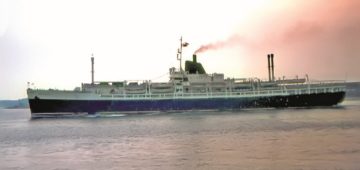



Comments
Sorry, comments are closed for this item